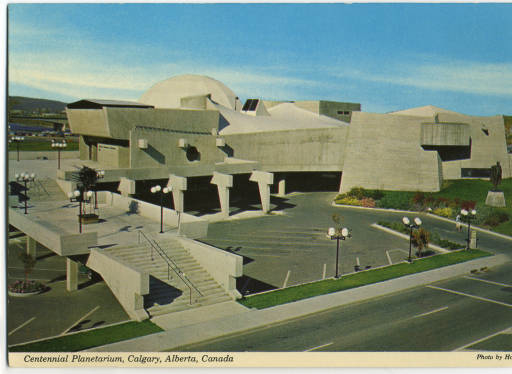Calgary's Brutalist Gem vs Gehry & Libeskind
I found this postcard of Calgary's Centennial Planetarium and was immediately struck by how similar it looked to some of the computer generated, multi-plane, cubist architecture of today - specifically starchitects, Frank Gehry and Daniel Libeskind.
I have always loved the juxtaposition of shapes that comprise Calgary architect Jack Long's Planetarium, but I have never been big fan of concrete as a facade material. Too me concrete seems lifeless as it doesn't interact with Calgary's wonderful sunshine like glass does. However, the '60s were the hey days for "brutalism" architecture ("beton brut"with means raw concrete in french) internationally - so everyone was doing it. Brutalism in many was responsible for creating the negative perception of downtowns and urban spaces as "concrete jungles."
Long is quoted as saying, "the design merged from the ideas of earth forms - sloping walls relate to river chasms, the freer forms were influenced by Le Corbusier and some of the work of Erich Medelsohn." To me it has the angularity of the rock formations one sees in the tectonics of the Rockies with its fold-and-thrust belts.
At the time it must have been a very modern futuristic design for a city that was struggling to define its urban sense of place locally, nationally and internationally.
Today the old Planetarium has been converted into Contemporary Calgary a public art gallery and next to it is the Shaw Millennium Park with one of the world’s largest public skateparks, which is a brutalist structure also.
Calgary's Centennial Planetarium preceded the '80s Deconstructivsim architecture movement by twenty years.
Conceptual drawing of the Centennial Planetarium
Frank Gehry, Guggenheim Museum, Bilbao, Spain
The Guggenheim Bilbao designed by Canadian/American architect Frank Gehry is one of the most popular modern buildings in the world. Built in 1997, (30 years after Long's Planetarium), it signalled a quantum change in architectural design as architects began to experiment with using computers to generate weird, wild and wacky shaped buildings.
The curves of the building have an organic feel to them and there is a randomness that results in an ever changing image as the different surfaces catch and absorb the light at different times of the day and with changes in the weather. The museum is considered by many to be a masterpiece of 20th century architecture and foreshadowed what was to come in the first decade of the 21st century.
The Guggenheim was responsible for the revitalization of the city of Bilbao, attracting millions of visitors to the city and creating the term "architectural tourism." Many cities have tried to imitate the success of Gehry, Guggenheim and Bilbao. Few have succeeded.
Guggenheim Museum, Bilbao, Spain
For example the design of the Art Gallery of Alberta in Edmonton Alberta shares many the characteristics of Gehry's Guggenheim Museum. Unfortunately the Randall Stout design has not become a major tourist attraction. It hasn't captured the imagination of Albertans.
The lesson to be learned here is "innovation" is better than "imitation" when it comes to urban revitalization. Every city is different - politicians, planners and public need to understand and capitalize on their city's unique sense of place.
Art Gallery of Alberta, Edmonton, Alberta
Jack Long: Missed Opportunity
It is interesting to speculate how Calgary might be different today if Jack Long, who died in 2001 had become an internationally celebrated architect in 1967 for his innovative Planetarium design. Imagine if Long had been commissioned to design the Petro Canada Tower, now the Suncor Energy Centre, instead of WZMH Architects from Toronto, designers of the CN Tower. I am sure Calgary's downtown would be a different place if Long had designed the TD Square complex, Scotia Tower, Municipal Building or Performing Arts Centre.
Would Calgary have become the Bilboa of North America?
Calgary would certainly have developed a more unique urban sense of place, rather than looking like any number of modern cities North American cities. Even today Calgary is still trying to import, rather than foster its sense of place with most of our major design projects going to a "Who's who" of international architects and artists - Calatrava, Foster, Plensa, Ingels and Snohetta.
Calgary's Municipal Building, designed by Toronto's WZMH Architects.
Daniel Libeskind vs Jack Long
The other famous international architect Long's Planetarium anticipates is Daniel Libeskind who has created controversial, eye-catching museums and art galleries around the world. In describing the inspiration for his addition to the Denver Art Museum, Libeskind referenced the folds and faults of the nearby Rocky Mountains and the shapes of the crystals formations in the rock.
Libeskind's Denver Art Museum
Libeskind's addition to the historic Royal Ontario Museum, Toronto, Canada
Long's Planetarium Revisited
Today, Long's Centennial Planetarium sits empty, while plans to transform it into a modern art museum are finalized. Over the years the building has evolved with new spaces and colour being added as the building's use evolved more into a Science Centre and children's museum.
In 2017, Canada will be celebrating its 150th birthday, wouldn't it be appropriate if Calgary's legacy project was the opening of the new Calgary Art Museum in the old Centennial Planetarium?
By Richard White, February 10, 2015
Centennial Planetarium as seen from the Bow River pathway.
Centennial Planetarium as seen from Shaw Millennium Park.
Next to the Centennial Planetarium is Shaw Millennium Park, one of the world's largest skateparks. The design of the Park with its concrete jumps, bowls and other forms is very synergistic to Long's brutalist design. In the background is the concrete West LRT bridge which enters and exits the downtown at the Planetarium, making it a dramatic gateway.





